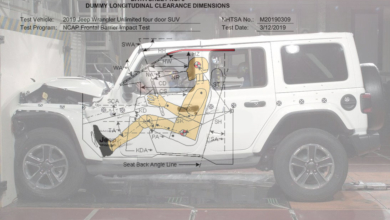Wrangler Jeep Vs Rubicon: The Ultimate Off-Road Showdown
Wrangler Jeep Vs Rubicon: The Ultimate Off-Road Showdown jeeps.truckstrend.com
The automotive world, particularly the realm of off-roading, is rife with iconic names, and few resonate as strongly as the Jeep Wrangler. For decades, the Wrangler has been the quintessential symbol of adventure, freedom, and unparalleled off-road capability. Within the Wrangler family, one name stands out as the undisputed king of the trail: the Rubicon. However, the common phrasing "Wrangler Jeep Vs Rubicon" often leads to a fundamental misunderstanding. The truth is, the Rubicon isn’t a separate vehicle; it is the pinnacle trim level of the Jeep Wrangler.
This article aims to clarify this distinction, providing a comprehensive guide that dissects the differences, advantages, and ideal use cases for the Rubicon trim versus other, equally capable (though perhaps less extreme) Wrangler variants. By understanding what truly sets the Rubicon apart and how it compares to its siblings like the Sport, Willys, or Sahara, prospective buyers and enthusiasts can make an informed decision that perfectly matches their adventurous spirit, budget, and off-road aspirations. This isn’t just about comparing two vehicles; it’s about understanding the nuances within a legendary lineage to find your perfect off-road companion.
Wrangler Jeep Vs Rubicon: The Ultimate Off-Road Showdown
Understanding the Jeep Wrangler Lineup: More Than Just One Vehicle
Before diving into the specifics of the Rubicon, it’s crucial to grasp the breadth of the Jeep Wrangler lineup. Since its inception, the Wrangler has evolved, offering various trim levels designed to cater to different needs and budgets. While all Wranglers share the same core DNA of rugged body-on-frame construction, solid axles, and a legendary 4×4 system, the standard features and capabilities vary significantly across trims.
Common Wrangler trims typically include:
- Sport/Sport S: The entry-level models, offering fundamental Wrangler capabilities, a strong foundation for customization, and the most accessible price point.
- Willys: A nod to Jeep’s military heritage, often adding more off-road focused features than the Sport, such as larger tires, rock rails, and improved shocks, bridging the gap towards more serious off-roading.
- Sahara: The more luxurious and street-oriented trim, often featuring body-colored fenders, premium interior materials, and advanced technology, making it a comfortable daily driver with competent off-road abilities.
- Rubicon: The focus of our deep dive – the most off-road capable production Wrangler ever built.
- Rubicon 392: The ultimate performance Wrangler, featuring a powerful V8 engine alongside all the Rubicon’s off-road prowess, built for high-speed desert running and rock crawling.
![]()
Each trim offers a unique blend of features, comfort, and off-road readiness. The "Wrangler Jeep Vs Rubicon" debate, therefore, is really about whether the specialized enhancements of the Rubicon are necessary for your specific adventures, or if another Wrangler trim provides a better balance of attributes.
The Rubicon Advantage: What Sets It Apart?
The Rubicon isn’t just a badge; it’s a meticulously engineered package of components designed to conquer the most challenging trails imaginable. These aren’t minor tweaks; they are fundamental differences that elevate the Rubicon’s off-road prowess far beyond its siblings.
![]()
Key Differentiating Features of the Rubicon:
- Heavy-Duty Axles (Dana 44 Front & Rear): While many Wranglers come with Dana axles, the Rubicon boasts heavy-duty wide-track Dana 44 front and rear axles. These are significantly stronger and more robust, capable of handling extreme articulation, larger tires, and the stresses of serious rock crawling. The wider track also enhances stability.
- Electronic Locking Differentials (Tru-Lok®): This is perhaps the most significant feature. Both the front and rear differentials can be electronically locked, forcing both wheels on an axle to spin at the same rate. This provides maximum traction in situations where one wheel might lift off the ground or lose grip, preventing power from being sent to the path of least resistance. Standard Wranglers rely on brake-lock differentials or open differentials.
- Electronic Front Sway Bar Disconnect (Active Sway Bar System): At the push of a button, the Rubicon can electronically disconnect its front sway bar. The sway bar limits wheel articulation on-road for stability. Off-road, disconnecting it allows for dramatically increased wheel travel and articulation, keeping tires in contact with the ground over uneven terrain and maximizing traction.
- Rock-Trac® 4×4 System: The Rubicon utilizes a specialized two-speed transfer case with a 4:1 low-range gear ratio (4LO). This extremely low gearing provides an incredible crawl ratio, allowing the vehicle to move very slowly and precisely over obstacles, enhancing control and torque delivery for extreme rock crawling. Other Wranglers typically use the Selec-Trac (2.72:1) or Command-Trac (2.72:1) systems.
- Larger, More Aggressive Tires: Rubicon models come standard with larger (often 33-inch or optional 35-inch with Xtreme Recon package), more aggressive off-road tires (e.g., BFGoodrich All-Terrain T/A KO2s). These tires offer superior grip, puncture resistance, and flotation on various challenging surfaces like rocks, mud, and sand.
- Higher Ground Clearance & Approach/Breakover/Departure Angles: Due to the larger tires and often a factory lift (or robust suspension), the Rubicon generally boasts superior ground clearance and more aggressive approach, breakover, and departure angles, allowing it to navigate steeper obstacles without scraping.
- Rock Rails: Standard rock rails protect the vehicle’s sills from damage when traversing rocky terrain.
- Heavy-Duty Suspension & Shocks: While all Wranglers have robust suspensions, the Rubicon’s setup is optimized for extreme off-roading, often featuring specific shocks tuned for more demanding conditions.
![]()
Benefits of these features for off-roading: The combination of these features makes the Rubicon a truly formidable off-road machine. It can tackle trails that would stop most other 4x4s in their tracks, offering unmatched traction, articulation, and durability for severe rock crawling, deep mud, and steep ascents/descents. It’s built to take a beating and keep going.
The Standard Wrangler Perspective: Capable, Customizable, and Practical
While the Rubicon is the king of extreme trails, it doesn’t mean other Wrangler trims are pushovers. Far from it. A Sport, Willys, or Sahara Wrangler is still incredibly capable off-road and often a more practical choice for many drivers.
Capabilities and Benefits of Other Wrangler Trims:
- Excellent Off-Road Foundation: Even the base Sport model comes with Jeep’s legendary 4×4 system, solid axles, and robust construction. It can handle moderate trails, fire roads, and light off-roading with ease.
- More Affordable Entry Point: Non-Rubicon trims are significantly less expensive, making the Wrangler dream accessible to a wider audience. This also leaves more budget for aftermarket modifications.
- Better On-Road Manners (Potentially): Trims like the Sahara, with their less aggressive tires and often more refined suspension tuning, tend to offer a quieter, smoother, and more comfortable ride for daily commuting and highway travel. The Rubicon’s specialized components can make it noisier, less fuel-efficient, and slightly less composed on pavement.
- Ideal for Customization: For enthusiasts who love to build their own rig, a Sport or Willys provides an excellent blank canvas. You can strategically add only the off-road components you need (e.g., a lift kit, bigger tires, lockers) without paying for factory features you might replace anyway. In some cases, building a highly capable Sport can even be more cost-effective than a Rubicon, depending on the desired level of modification.
- Wider Range of Configurations: Non-Rubicon trims often offer a broader spectrum of interior finishes, technology packages, and exterior colors, appealing to those who prioritize comfort and aesthetics alongside capability.
Target Audience: Standard Wranglers are best for daily drivers who want significant off-road capability for weekend adventures, those on a tighter budget, or enthusiasts who prefer to hand-pick every modification to create a truly unique and personalized off-road machine.
Performance and Driving Experience Comparison
The choice between a Rubicon and another Wrangler trim often boils down to a trade-off between extreme off-road prowess and on-road civility.
Off-Road Performance:
- Rubicon: Unmatched in its class for rock crawling and tackling highly technical terrain. The electronic lockers, sway bar disconnect, and low crawl ratio provide incredible control and traction in the most challenging situations. It truly shines when the trail gets gnarly.
- Other Wranglers: Highly capable for general off-roading, including forest trails, light rock crawling, sand dunes, and mud. They can get to many places the Rubicon can, just perhaps not as easily or through the most extreme lines. For 90% of off-road enthusiasts, a Sport, Willys, or Sahara will be more than sufficient.
On-Road Driving Experience:
- Rubicon: The aggressive tires, stiffer suspension, and specialized gearing can make it feel less refined on pavement. Expect more road noise, potentially a slightly harsher ride, and generally lower fuel economy. It’s built for the trail, and that translates to a compromise on the road.
- Other Wranglers: Generally offer a more comfortable and quieter ride for daily driving. The Sahara, in particular, is designed with on-road comfort in mind, making it an excellent choice for those who split their time between city streets and occasional adventures. Fuel economy will still be modest due to the vehicle’s aerodynamics and weight, but often better than a Rubicon.
Cost and Value Proposition
The price difference between a Rubicon and other Wrangler trims is substantial, and this is a critical factor for most buyers.
- Initial Cost: The Rubicon commands a significant premium over the Sport, Willys, and Sahara trims. This premium covers the advanced off-road hardware discussed earlier. For example, a Rubicon can easily be $10,000 to $20,000+ more than a comparable Sport S.
- Resale Value: All Jeep Wranglers, regardless of trim, are renowned for holding their resale value exceptionally well. The Rubicon, being the most capable and desirable off-road trim, tends to retain its value very strongly, appealing to a dedicated niche market of off-road enthusiasts. However, other trims also perform admirably in this regard.
- Modification Costs: If your goal is to build a vehicle as capable as a Rubicon from a Sport, you’d need to invest heavily in aftermarket axles, lockers, a transfer case, lift kits, and larger tires. The cost of these modifications can quickly add up, potentially exceeding the factory premium of a Rubicon. However, if you only need some of the Rubicon’s features or plan a different style of build, starting with a less expensive trim can be more economical.
Choosing Your Wrangler: Practical Advice and Actionable Insights
Deciding between a Rubicon and another Wrangler trim requires honest self-assessment of your needs, budget, and intended use.
- Assess Your Off-Roading Intentions:
- Extreme Rock Crawling/Hardcore Trails: If you dream of tackling the most challenging, technical trails with large boulders and steep obstacles, the Rubicon’s factory capabilities are invaluable and likely worth the investment.
- Moderate Trails/Overlanding/Light Off-Roading: For fire roads, forest trails, camping trips, or occasional beach runs, a Sport, Willys, or Sahara will perform admirably. You might consider minor upgrades like better tires or a small lift, but the core vehicle is already highly capable.
- Consider Your Daily Driving Habits:
- Daily Commuter/Primary Vehicle: If the Wrangler will be your primary mode of transportation, especially for long commutes or highway driving, a Sahara or even a Sport S might offer a more comfortable and refined on-road experience. The Rubicon’s aggressive nature can become tiresome.
- Weekend Warrior/Dedicated Trail Rig: If the Wrangler is a second vehicle primarily for off-road adventures, the Rubicon’s on-road compromises become less of an issue.
- Define Your Budget: Be realistic about what you can afford for the initial purchase and ongoing costs (fuel, insurance, potential modifications). The Rubicon’s higher price tag extends to higher insurance premiums and potentially higher maintenance costs for its specialized components.
- Evaluate Your Mechanical Aptitude & Modification Plans:
- Buy-It-And-Go: If you want maximum capability straight from the factory without much fuss, the Rubicon is your choice.
- Build-It-Yourself: If you enjoy wrenching and want to customize your rig piece by piece, starting with a less expensive trim (like a Sport or Willys) can be a rewarding and potentially more cost-effective path to a highly capable vehicle tailored to your exact specifications.
- Test Drive Both! This cannot be stressed enough. Drive a Rubicon and at least one other Wrangler trim (e.g., a Sahara or Willys) on both pavement and, if possible, on some light off-road terrain. Feel the differences in ride quality, noise, and handling.
Price Table: Jeep Wrangler Trim Levels (Approx. 2024 MSRP)
Please note: Prices are approximate MSRPs and can vary significantly based on configuration (2-door vs. 4-door, engine choice, manual vs. automatic transmission, options, packages, and regional pricing). This table provides a general guide.
| Trim Level | Starting MSRP (Approx.) | Key Standard Features (Compared to lower trims) | Target User / Best For |
|---|---|---|---|
| Sport | $32,000 – $36,000 | Command-Trac 4×4, Dana 30/35 axles, 17-inch wheels, removable top/doors, Uconnect infotainment. | Budget-conscious, daily driver with light off-road needs, perfect base for extensive aftermarket modifications. |
| Sport S | $35,000 – $39,000 | Adds power windows/locks, air conditioning, leather-wrapped steering wheel, alloy wheels. | Step up from Sport, adds comfort/convenience for daily driving, still great for customization. |
| Willys | $39,000 – $44,000 | Adds 32-inch mud-terrain tires, Trac-Lok rear limited-slip diff, rock rails, heavy-duty shocks, black grille/wheels. | Heritage look, enhanced off-road capability out-of-the-box, good value for trail enthusiasts without needing full Rubicon. |
| Sahara | $40,000 – $46,000 | Body-color fenders, LED lighting, Uconnect 5, larger display, premium interior, Selec-Trac Full-Time 4×4 (optional). | Comfort-focused, daily driver, tech-savvy, moderate off-road capability, more refined on-road. |
| Rubicon | $46,000 – $52,000 | Rock-Trac 4×4 (4:1 low-range), Electronic Front/Rear Locking Diffs, Electronic Sway Bar Disconnect, Heavy-Duty Wide-Track Dana 44 Axles, 33-inch Off-Road Tires, Rock Rails. | Serious off-road enthusiasts, rock crawlers, those who demand maximum factory capability, frequent extreme trail use. |
| Rubicon 392 | $90,000+ | 6.4L HEMI V8 engine (470 hp), Fox shocks, high-performance brakes, unique hood, all Rubicon features, higher ride height. | Ultimate performance, high-speed desert running, luxury off-roading, power enthusiasts. |
Frequently Asked Questions (FAQ)
Q1: Is the Rubicon worth the extra money?
A1: It depends entirely on your intended use. If you consistently tackle extreme, technical off-road trails (like those found in Moab, Utah, or the Rubicon Trail itself), then the factory features of the Rubicon are incredibly valuable and difficult/expensive to replicate aftermarket. For casual off-roading or primarily street driving, the extra cost may not be justified.
Q2: Can I make a Sport/Sahara as capable as a Rubicon?
A2: Yes, with significant aftermarket investment. You can install stronger axles, locking differentials, better transfer cases, lift kits, and larger tires. However, the cost of these high-quality components and professional installation can often exceed the price difference of simply buying a Rubicon from the start, especially for the full suite of Rubicon features. It’s often more economical to start with a Rubicon if you want all its features.
Q3: Which Wrangler is best for daily driving?
A3: The Sahara trim typically offers the most comfortable and refined on-road experience due to its less aggressive tires, often body-colored hardtop, and premium interior features. The Sport S is also a good daily driver option, offering a balance of capability and comfort. The Rubicon, while capable, makes more compromises for on-road comfort due to its specialized off-road components.
Q4: Do all Wranglers have removable tops and doors?
A4: Yes, all Jeep Wrangler models (JL generation and previous) come standard with removable doors and a removable top (either soft top, hardtop, or Sky One-Touch Power Top). This iconic feature is universal across the Wrangler lineup, regardless of trim.
Q5: What’s the difference between the Rock-Trac and Selec-Trac/Command-Trac 4×4 systems?
A5:
- Rock-Trac (Rubicon): Features a 4:1 low-range gear ratio, providing superior torque multiplication and precise control for extreme low-speed rock crawling. It also includes electronic locking differentials.
- Selec-Trac (Optional on Sahara/Willys, Standard on Rubicon 392): A full-time 4×4 system that can be used on paved roads. It automatically shifts power between the front and rear axles as needed, offering enhanced traction in varying conditions. Its low-range ratio is typically 2.72:1.
- Command-Trac (Sport/Sport S/Willys): A part-time 4×4 system that should only be used off-road or on slippery surfaces. It has a 2.72:1 low-range ratio and requires the driver to engage 4WD.
Q6: Are there other off-road focused Wranglers besides the Rubicon?
A6: Yes, the Willys trim offers a significant step up in off-road capability over the Sport, often including larger tires, rock rails, and a limited-slip differential. Jeep also offers the Xtreme Recon package on select trims, which adds 35-inch tires, beadlock-capable wheels, and a factory lift for even greater off-road prowess.
Concluding Summary
The "Wrangler Jeep Vs Rubicon" comparison is not about two distinct vehicles, but rather a deep dive into the most capable variant within the legendary Jeep Wrangler family. The Rubicon stands as the undisputed champion of factory off-road capability, boasting specialized components like electronic locking differentials, a disconnecting sway bar, and a low-range transfer case that allow it to conquer terrains that would halt nearly any other production vehicle.
However, this extreme capability comes with a higher price tag and some compromises in on-road comfort and fuel efficiency. For the majority of enthusiasts, a Sport, Willys, or Sahara Wrangler offers a remarkable blend of everyday usability and impressive off-road prowess, often at a more accessible price point. These trims serve as excellent platforms for customization, allowing owners to tailor their vehicle to their precise needs without overpaying for features they might not use or intend to replace.
Ultimately, the best Wrangler is the one that aligns perfectly with your specific adventures, driving habits, and budget. Whether you opt for the hardcore, trail-ready Rubicon or a highly capable and customizable standard Wrangler, you’re choosing a vehicle steeped in heritage, renowned for its go-anywhere spirit, and guaranteed to deliver an unforgettable open-air experience. The adventure awaits, no matter which Wrangler you choose.




